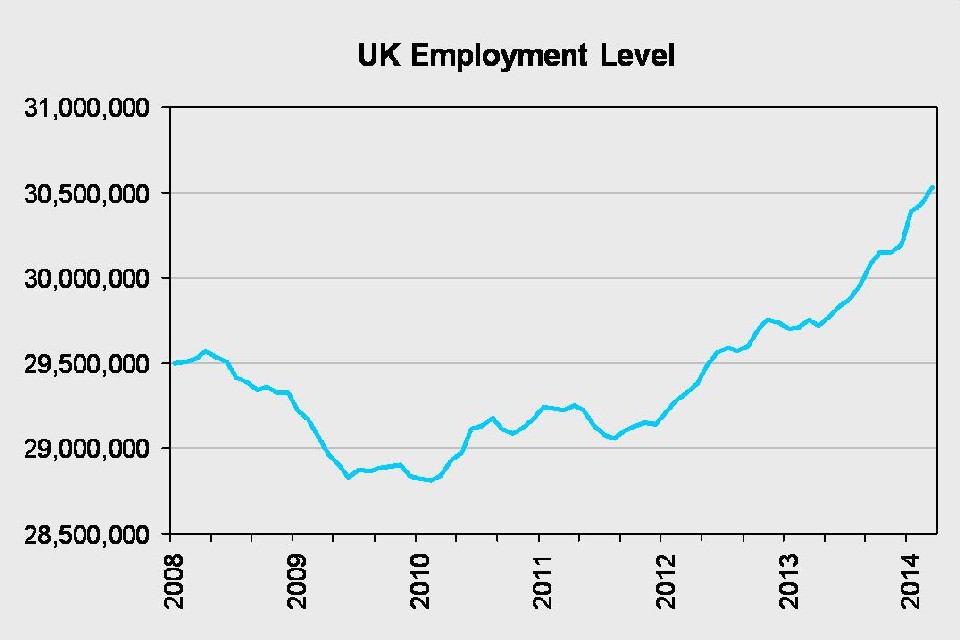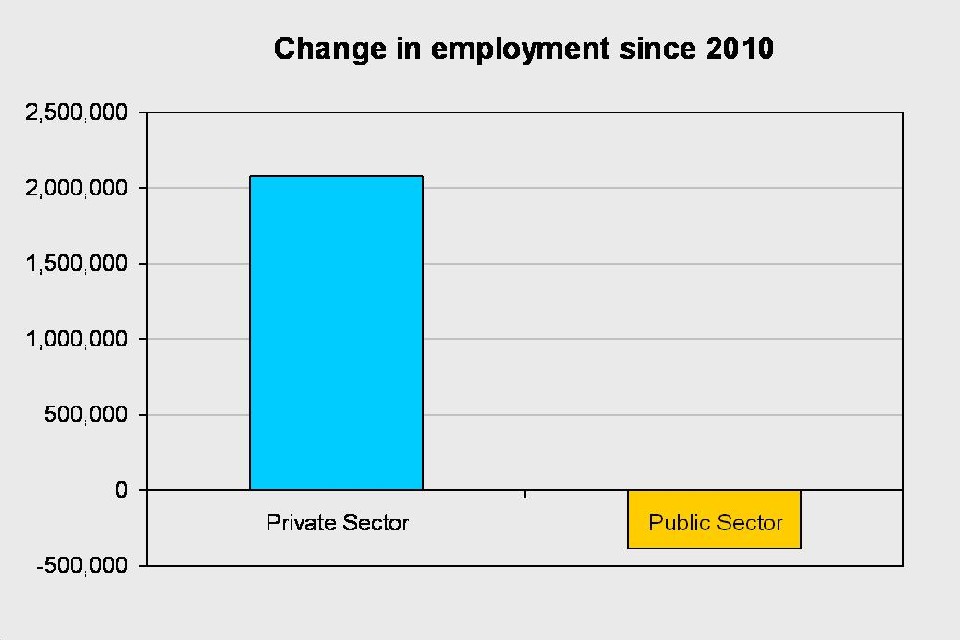Improving economy sees 2 million more private sector jobs
A record employment rise saw nearly 5,500 more people in work every working day over the last 3 months.

A record employment rise saw nearly 5,500 more people in work every working day over the last 3 months, with the number of private sector workers up by more than 2 million since 2010, according to official figures published today (11 June 2014).
Employment increased by a record-breaking 345,000 in just 3 months. Compared to a year ago, 780,000 more people are in work – the biggest annual rise in a quarter of a century, in a further sign the government’s long-term economic plan is working. This brings the total number of people in work to over 30.5 million for the first time ever and the employment rate is now 72.9% – just 0.1 percentage point below the pre-recession peak and 0.2% percentage points below the highest rate on record.

Unemployment also saw the biggest annual fall in 16 years, down by 347,000, bringing the unemployment rate to a new 5 year low of 6.6%. Long-term unemployment also fell by 108,000 on the year, the largest annual fall since 1998.
The number of unemployed young people fell again – for the ninth month in a row – down by 59,000 in 3 months. The number of young people claiming Jobseeker’s Allowance (JSA) has now been falling for 30 consecutive months.
The positive youth employment figures come on the day that young jobseekers are putting Spurs legend Ledley King and business leaders from Microsoft, Hilton International, Land Securities and Employment Minister Esther McVey in the hotseat for a debate on jobs and careers.
Minister for Employment Esther McVey said:
As we build a stronger economy, businesses up and down the country are feeling increasingly confident about creating jobs, meaning many thousands more people are in work every day – ensuring a better future for them, their families, and for the country as a whole.
Helping young people to get a job is vital to securing our economic future, so it’s welcome that youth unemployment has continued to fall – we’ll continue to do all we can to inspire the next generation of employers and business leaders and help them to build their careers.
Today’s figures show that over three quarters of the employment increase over the last 3 months was employee jobs, and private sector employment is up 795,000 from a year earlier.

The number of people claiming JSA fell by 27,400 this month and is down 406,300 compared to a year ago – the largest annual fall since 1998. The number of people claiming JSA for more than 12 months fell by 100,500 on the year, the largest annual fall in nearly 16 years.
Job vacancies rose again, up 116,000 over the past year bringing the number of vacancies in the UK economy to 637,000.
Later today, Spurs legend Ledley King, Microsoft, Hilton International, Land Securities and the BBC are joining forces with Employment Minister Esther McVey to network with young jobseekers from local jobcentres and will have the opportunity to put their questions to the business leaders and employment experts from the CIPD and the National Careers Service to help tackle the issues they are confronted with when looking for work, and the skills they need to get in and get on.
Background to labour market statistics: June 2014
This month’s Labour Force Survey covers February 2014 to April 2014. The claimant count is for May 2014 and the vacancy count for March 2014 to May 2014.
The number of people in work rose this quarter
- 30.54 million people were in work in February to April 2014
- the employment level rose 345,000 on the previous quarter and 780,000 on the year
- the employment rate is 72.9%, up 0.6 points on the quarter and up 1.4 points on the year
ILO unemployment fell this quarter
- 2.16 million people were ILO unemployed in the February to April 2014 quarter, down 161,000 on the previous quarter and 347,000 on the year
- the ILO unemployment rate is 6.6%, down 0.5 points on the quarter and down 1.2 points on the year
The level of economic inactivity is down on the quarter and on the year
- the economic inactivity level is 8.82 million in the February to April 2014 quarter, down 80,000 on the previous quarter and 178,000 on the year
- the economic inactivity rate is 21.8%, down 0.2 points on the quarter and down 0.5 points on the year
- excluding students, inactivity as a share of the 16-64 population is 16.3%, down 0.1 points on the quarter and down 0.5 points on the year
The number of people claiming one of the main out-of-work benefits is falling
- claimant unemployment was 1.09 million in May 2014, down 27,400 on the month and down 406,300 on the year
- the claimant count rate is 3.2%, down 0.1 points on the month and down 1.2 points on the year
- in the year to November 2013, the number claiming incapacity benefits fell 43,600 to 2.46 million – the most recent provisional figure for April 2014 suggests the caseload has risen slightly since then
- in the year to November 2013, the number of lone parents on income support fell 25,000 to 485,000. The provisional figure for April 2014 is 475,000
The number of redundancies rose and unfilled vacancies rose on the quarter
- there were 120,000 redundancies in February to April 2014, up 3,000 on the previous quarter but down 21,000 on the year
- ONS’ vacancy survey estimates an average of 637,000 unfilled vacancies in the 3 months to May 2014, up 39,000 on the previous quarter and 116,000 on the year
Total weekly pay in April 2014 was up by 0.7% over the year
- growth in regular weekly pay, excluding bonuses, was up by 0.9% on the year
Contact Press Office
Media enquiries for this press release – 020 3267 5161
Press Office
Caxton House
Tothill Street
London
SW1H 9NA
Telephone: 0115 965 8781
Follow DWP on:
- Twitter – www.twitter.com/dwppressoffice
- Facebook – www.facebook.com/dwp
- LinkedIn – www.linkedin.com/company/dwp
- YouTube – www.youtube.com/dwp